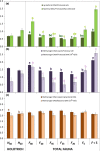Study of methanogen communities associated with different rumen protozoal populations
- PMID: 25195951
- PMCID: PMC4286163
- DOI: 10.1111/1574-6941.12423
Study of methanogen communities associated with different rumen protozoal populations
Abstract
Protozoa-associated methanogens (PAM) are considered one of the most active communities in the rumen methanogenesis. This experiment investigated whether methanogens are sequestrated within rumen protozoa, and structural differences between rumen free-living methanogens and PAM. Rumen protozoa were harvested from totally faunated sheep, and six protozoal fractions (plus free-living microorganisms) were generated by sequential filtration. Holotrich-monofaunated sheep were also used to investigate the holotrich-associated methanogens. Protozoal size determined the number of PAM as big protozoa had 1.7-3.3 times more methanogen DNA than smaller protozoa, but also more endosymbiotic bacteria (2.2- to 3.5-fold times). Thus, similar abundance of methanogens with respect to total bacteria were observed across all protozoal fractions and free-living microorganisms, suggesting that methanogens are not accumulated within rumen protozoa in a greater proportion to that observed in the rumen as a whole. All rumen methanogen communities had similar diversity (22.2 ± 3.4 TRFs). Free-living methanogens composed a conserved community (67% similarity within treatment) in the rumen with similar diversity but different structures than PAM (P < 0.05). On the contrary, PAM constituted a more variable community (48% similarity), which differed between holotrich and total protozoa (P < 0.001). Thus, PAM constitutes a community, which requires further investigation as part of methane mitigation strategies.
Keywords: archaea; endosymbiotic; holotrich; methanogens; rumen protozoa.
© 2014 The Authors. FEMS Microbiology Ecology published by John Wiley & Sons Ltd on behalf of Federation of European Microbiological Societies.
Figures




References
-
- Abecia A, Waddams KE, Martínez-Fernandez G, Martín-García AI, Ramos-Morales E, Newbold CJ. Yáñez-Ruiz DR. An antimethanogenic nutritional intervention in early life of ruminants modifies ruminal colonization by Archaea. Archaea. 2014 In press. DOI: 10.1155/2014/841463. - DOI - PMC - PubMed
-
- Anderson MJ. A new method for non-parametric multivariate analysis of variance. Austral Ecol. 2001;26:32–46.
-
- Belanche A, De la Fuente G, Yáñez Ruiz DR, Newbold CJ, Calleja L. Balcells J. Technical note: the persistence of microbial-specific DNA sequences through gastric digestion in lambs and its potential use as microbial markers. J Anim Sci. 2011a;89:2812–2816. - PubMed
-
- Belanche A, Abecia L, Holtrop G, Guada JA, Castrillo C, de la Fuente G. Balcells J. Study of the effect of presence or absence of protozoa on rumen fermentation and microbial protein contribution to the chyme. J Anim Sci. 2011b;89:4163–4174. - PubMed
-
- Belanche A, de la Fuente G, Moorby JM. Newbold CJ. Bacterial protein degradation by different rumen protozoal groups. J Anim Sc. 2012a;90:4495–4504. - PubMed
Publication types
MeSH terms
Substances
LinkOut - more resources
Full Text Sources
Other Literature Sources
Miscellaneous

